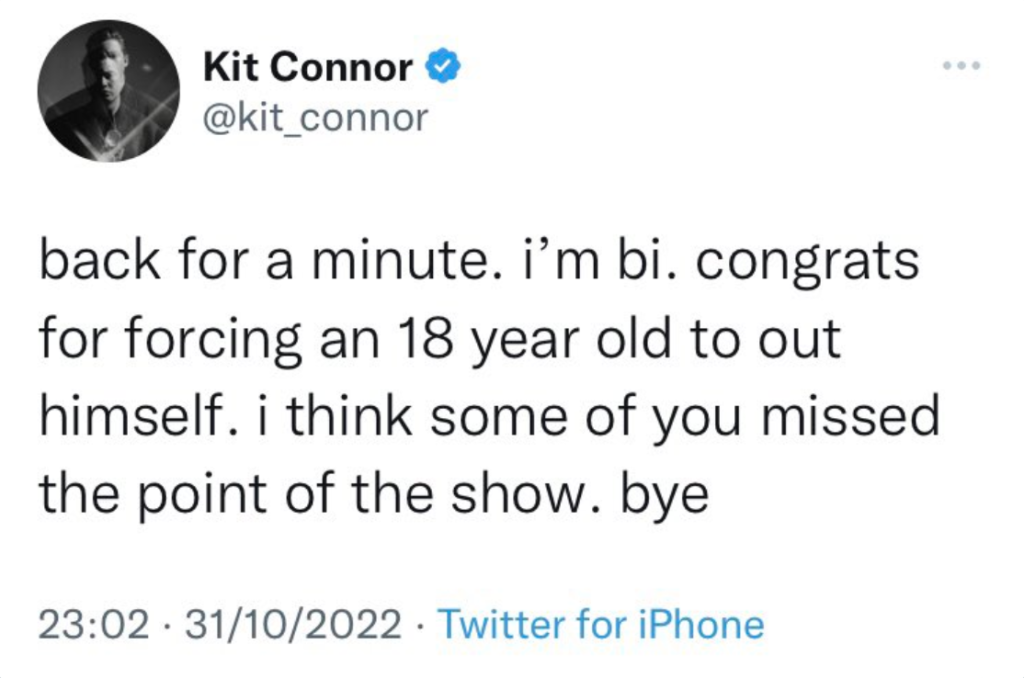Heartstopper‘s Kit Connor should have never been accused of queer baiting.
Typically, queer baiting happens when fictional media alludes to a character’s queerness but never explicitly defines their sexuality. It’s a technique that keeps LGBTQ+ audiences invested because they wait to see if a queer arc actually develops. It’s a frustrating technique, as seeing LGBTQ+ characters on screen can be one of the most validating experiences for a young person, so when let down, its extremely disheartening.
As mentioned above, tv shows, movies and books are usually the guilty culprits when it comes to the practice. However, more recently, celebrities have been accused of queer baiting when they choose not to comment on their sexuality even though their style or behaviour suggests that they might be part of the LGBTQ+ community (whatever that means).
In some cases, celebrities who aren’t ready to publicly share their sexuality will ‘flag’ their queer identity to knowing fans. This practice is known as ‘queer flagging’ and is a code that began being documented in the ’70s as a way for people to signal their sexual identity to other queers. For gay and bisexual men, this often involved tucking a handkerchief into their back pocket. For lesbians and bisexual women, they could quietly indicate their sexuality to others by wearing violets on their clothing. The idea is that the flag is obvious enough to attract the attention of other queers, but subtle enough to be ignored by the straight community.
It’s still a practice that’s used today. For example, as recently as 2021, asking “Do you listen to Girl in Red?” became a queer coded way for women to inquire about another’s sexuality without outing themselves first. Other queers recognised the artist, where straight people were more likely to answer honestly and say, “No” they didn’t listen to her or hadn’t heard of her.
Some celebrities are known for queer flagging by including queer references in their music, style, and interviews. But this isn’t always obvious or clear.
In Kit’s case, he wasn’t inviting speculation. In fact, when prompted by media outlets in May 2022, Connor said that he did not want to label his sexuality yet, which is a choice that deserved respect.
Although the actor had not commented publicly on his identity, it was widely assumed that he was queer until he was photographed holding hands with a woman. Disappointed fans quickly accused Heartstopper‘s star of queer baiting, insinuating that he was only pretending to be a member of the LGBTQ+ community to attract fans. This obligated the young actor to publicly come out as bisexual, which he did before deactivating his Twitter account.
Assuming someone’s sexuality based on their romantic partner is always unfair, and Kit Connor’s statement was heartbreaking to read:

Unfortunately, bisexuality continues to be invalidated and stigmatised. Even though Heartstopper openly discussed bi stereotypes and addressed common misunderstandings, fans still assumed Kit was straight because he was holding hands with a woman. Ironically, if he had been holding hands with a male, fans probably would have assumed he was gay.
Speculating about an actor’s sexuality is natural, the problem comes when someone is forced to come out before they are ready. Rebel Wilson recently shared her experience of being forced to come out publicly by a reporter who threatened to out her in the media. Wilson shared that her and her partner were in the process of sharing the news with close friends, dealing with family members who were not as accepting as they’d hoped, and she was trying to come out in her own time and in her own way.
In the cases of Kit Connor and Rebel Wilson, they weren’t doing anything to purposely invite speculation.
So when a celebrity has an obviously queer style or hints at a gay relationship without publicly labelling their sexuality, is that queer baiting or queer flagging?
For example, Harry Styles regularly incorporates queer flags into his concerts. Olivia Rodrigo’s best friend shared photos of them cuddling that invited speculation about their relationship. Similarly, Taylor Swift shared a photo of herself wearing a bi pride bracelet, and she recently liked a series of TikTok videos with the “Gaylor” hashtag. In these cases, it can be difficult to discern a celebrity’s intentions. Are they signalling that they are one of us? Are they showing allyship? Or are they just catering to a queer fan base for money? It’s justified to be angry about the last bit.
Sexuality and gender are complex and often fluid. Queer flagging helps us find community and connection, while queer baiting makes us feel used. It’s important to remember that celebrities, especially young stars, deserve the time and privacy to share their sexuality in their own way and on their own terms.
Ultimately, the distinction is really simple. It’s okay to allude to your queerness if you are LGBTQ+. It is not okay to pretend to be queer if you aren’t. And celebrities should be free to express their sexual identity as little or much as they want when they are ready to share.
© 2022 GCN (Gay Community News). All rights reserved.
Support GCN
GCN is a free, vital resource for Ireland’s LGBTQ+ community since 1988.
GCN is a trading name of National LGBT Federation CLG, a registered charity - Charity Number: 20034580.
GCN relies on the generous support of the community and allies to sustain the crucial work that we do. Producing GCN is costly, and, in an industry which has been hugely impacted by rising costs, we need your support to help sustain and grow this vital resource.
Supporting GCN for as little as €1.99 per month will help us continue our work as Ireland’s free, independent LGBTQ+ media.
